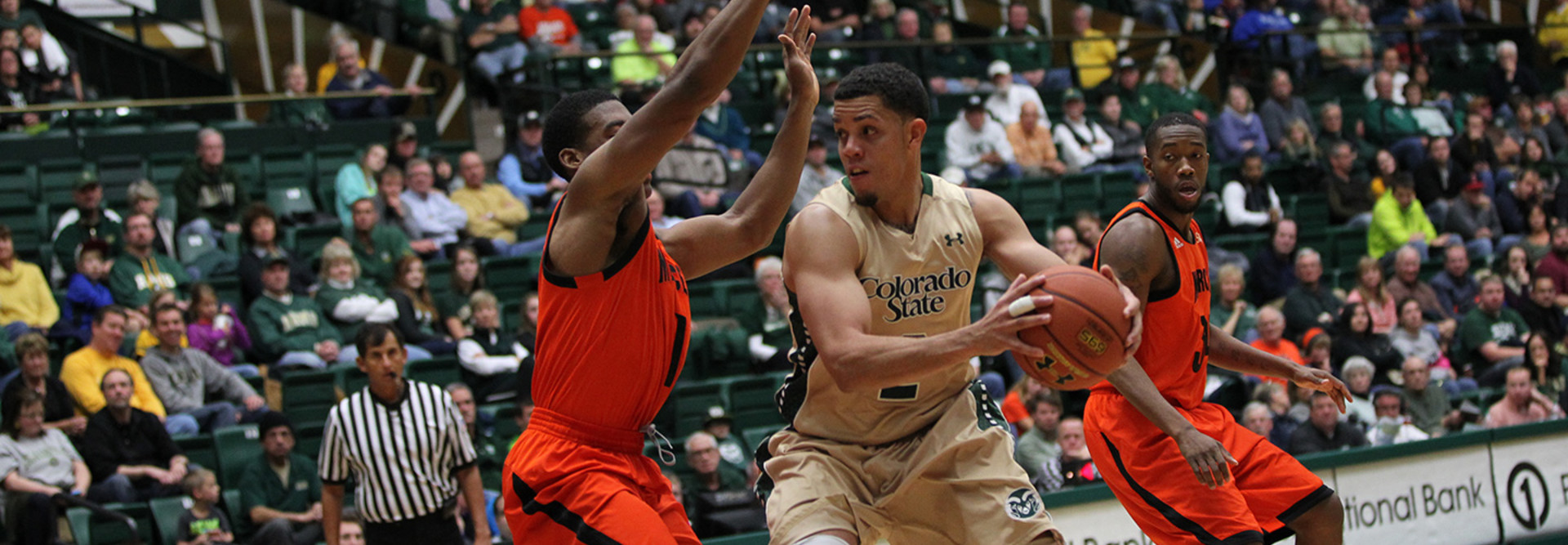Colorado State University Finds an Edge with Basketball Analytics
When the game is on the line and Colorado State University needs to make a defensive stop, head coach Larry Eustachy will place his five best defensive players on the floor — and now he can do it with increased confidence, thanks to advanced statistics.
For example, the coaching staff knows that junior guard Joe De Ciman, with his 6-foot-10-inch wingspan, is good defensively. They just didn’t realize how good.
De Ciman’s “defensive impact” near the basketball rim is phenomenal: Opposing players shoot only 29 percent against him near the basket where players, on average, make a majority of their shots up close.
“That means the people he is guarding are not getting clean looks to the basket,” says Willie Glover, the team’s video coordinator, who develops scouting reports and handles data analytics. “We have plenty of capable defenders. But if it’s crunch time, and we’re playing against an elite scoring guard who likes to attack, based on the numbers, we know that the opposition usually struggles to get into a scoring rhythm when guarded by De Ciman.”
Advanced analytics has transformed the NBA, and now it’s making inroads into the college game. This year, the Colorado State Rams joined three other college men’s basketball teams (Duke, Louisville and Marquette) in adopting Stats LLC’s SportVU player-tracking technology.
Six SportVU video cameras, perched high above Moby Arena, capture every player and ball movement, producing new statistics, such as points per possession, secondary and free-throw assists and rebounding percentage. The technology also uncovers patterns and trends, such as where on the court a team gives up the most points or where a team has a tendency to turn the ball over.
Colorado State, which excelled to a 27–6 record this year in the Mountain West Conference, uses the statistics to gain a competitive edge. The new information allows coaches to better gauge player and team performance, and it helps augment the decision-making process by confirming what they see from practices and games.
“We don’t use it for decision-making, but it allows us to feel comfortable with the decisions we make,” says Glover, whose team was snubbed by the NCAA and wasn’t included in March Madness, the NCAA Division I Men’s Basketball Tournament, but is a No. 1 seed in the National Invitation Tournament.
New Numbers Don’t Lie
The numbers in a traditional box score don’t always tell the whole story, Glover says. For example, one player may have six rebounds in a game, while another player has 12. But the first player may have had a better rebounding game if he grabbed rebounds in 100 percent of his chances, while the second player only got rebounds in 60 percent of his chances.
Similarly, a guard may have had only three assists officially in a game, but if he dished out 10 potential assists, then it’s proof that the player is not selfish. A potential assist is a pass to a teammate who misses a shot.
“It helps us stay confident that a player is doing well and not getting frustrated with the numbers we see during a game, because it goes more in-depth than that,” Glover says.
Colorado State captures SportVU data for its 16 home games and uses it to analyze the team. With such a small sample size, Glover compiled and shared SportVU data with coaches every fourth home game, so there’d be enough data to analyze.
“Coach looks at all the stats, and he’s open to all the ideas that derive from it,” Glover says. “But because he stresses defense, he loves to hear the rebounding numbers. That’s the kind of stat that gets him going and excited.”
For example, junior forward Tiel Daniels gets 81 percent of contested offensive rebounds when an opposing player is within three-and-a-half feet of the ball.
Improving Offensive and Defensive Efficiency
On offense, Eustachy focuses on ball movement and passing the ball. This year, the SportVU data confirmed that the team does well with passing, averaging 327.4 passes per game, which is 100 more passes per game than CSU’s opponents, Glover says.
This year, coaches also discovered that they are most efficient — meaning they are most successful in scoring — during a certain segment of the 35-second shot clock. So during the season, coaches emphasized to the team that they should try to score during that portion of the shot clock, he says.
“We want to put our players in a position where they can be most successful,” Glover says. “We know, in certain situations, where our players are most efficient in the areas on the court, and we want them in those areas. And, defensively, we know the true impact that we are getting from each player.”
Colorado State takes advantage of other analytics tools beyond SportVU. It subscribes to basketball stats guru Ken Pomeroy’s data analytics service. It also pairs SportVU with SportsTec’s SportsCode video software technology, so the team can view specific video that pertains to a statistic, such as every catch-and-shoot three-point attempt made in a game.
Moving forward, Glover is hopeful that more college teams will adopt SportVU and that the Mountain West Conference could one day install it throughout the 12-team conference.
One of the main reasons the technology is so beneficial in the NBA is because it’s installed in every arena, providing every team with stats for all of their home and away games. All the data is shared among teams, so they can better analyze their opponents.
Right now, if one player at San Diego State scores a lot against Colorado State during a single game, Colorado State can use SportVU to pinpoint who on its team is giving up the most points and make adjustments in the next game. But having more data on opponents will allow the Rams to discover more of their opponents’ tendencies and weaknesses.
“Analytics plays a big part in getting your team as efficient as possible. It’s really beneficial and lets you know everything,” Glover says. “If every school had it, it would be even more beneficial, because we can analyze their style of play, and we would have more evidence of where we are the most efficient.”
Want to learn more about how analytics is transforming college basketball? Read our story about Duke University's success with integrating performance data into its coaching program.









